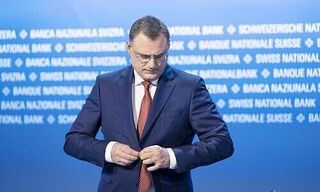Banks are weathering the initial months of the coronavirus. The risk of a banking and financial crisis looms in a flare-up of the pandemic.
While health officials warn of a second wave of the three-month-old pandemic, stock markets continue to rise. The bizarre side effect of this global crisis illustrates that investors are taking little notice of doomsday predictions by economists, luxuriating instead in a flood of money from the U.S. Federal Reserve and the European Central Bank.
Central bankers and some finance executives are more circumspect, fretting over the economic implications of a second wave of coronavirus.The prospect of a liquidity crisis for banks and in the financial system is real, according to several Swiss bankers queried by finews.com.
Tapping Credit Lines
Specifically, they voice fears that an accentuation of the economic crisis could tip more companies into insolvency – sending credit defaults at banks surging. Those spared will revisit credit lines in March and April they tapped in the initial panicked weeks of the crisis to pad their liquidity cushions.
This type of «run» on credit, the bankers report, can lead to liquidity issues for banks – the interbank market threatens to dry up when institutes refused to lend to each other anymore (a phenomenon vividly demonstrated on a large scale in 2008/09).
Policymakers, Supervisors Warn
There are considerable ifs and buts in the scenario. However, the fact the central bankers and financial supervisors have it in their sights speaks volumes – and they are already issuing warnings.
«A huge economic danger in my view would be a credit freeze: that banks don't have enough capital to write new loans,» Finma head Mark Branson said in an interview on Thursday. In the U.S., St. Louis Fed President James Bullard warned an outright financial crisis may loom, in an interview with the «Financial Times» (behind paywall).
Clamor For Liquidity
These warnings from supervisors represent cautionary statements. Money markets were already under enormous strain in March when banks needed to fulfill a clamor for liquidity – an estimated $500 billion globally, an investment banker noted. Or as Switzerland's Branson said, «Liquidity bottlenecks appeared at a dramatic speed.»
Lenders also piled into Switzerland's money market in April, but demand was tricker. Funding in the interbank market was tighter, and costlier. After a dramatic collapse in financial markets, banks feared loan losses – a backdrop against which most lenders seize up.
Big Corporates Vs. Small Business
For Swiss banks, the worry is less over a crop of small- and mid-sized businesses which form the backbone of the domestic economy – a more than $40 billion lending package for them is government-backstopped, and hasn't yet been exhausted.
What worries Swiss corporate bankers more is large companies that disrupted supply chains and a massive surge in cash needs, one Swiss-based banker told finews.com. This would squeeze banks and shut the lending spigot, in turn tipping some companies into insolvency and piling loan losses on lenders.
No Loans, Or Tighter Terms
Some banks simply couldn't lend on a large scale because their capital is too thin, others would tighten loan terms and covenants. The Swiss property market represents another risk of a credit freeze: online consumer tool Comparis noted that mortgage lending rates are in leap-frog mode.
Finma's Branson said on Thursday that real estate market risks remain high; the regulator as well as the Swiss National Bank temporarily released banks from a mortgage-related capital buffer when corona hit – a bid to get small business loans out the door faster.
If home prices keep falling – a likely scenario in a recession – the real estate market is a ticking time bomb. Mortgage defaults would eat into the capital cushions at banks – the same cushion that was waived and used elsewhere.




























